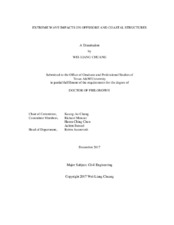| dc.description.abstract | This dissertation presents an experimental investigation of three different scenarios on the interaction between extreme waves and offshore/coastal structures: (1) plunging breaking wave impingement on a tension-leg platform (TLP); (2) green water caused by focusing wave and random seas on an offshore platform in a large wave basin; and (3) tsunami bore impact on a coastal building. The bore, green water, or breaking wave is usually multiphase and highly turbulent. To quantify such flows, the bubble image velocimetry (BIV) technique was employed. In addition, the applicability of the BIV technique on moving structures as well as on two perpendicular view planes was validated. The void fraction (air volumetric fraction) in the aerated flows was obtained from the time series of phase transition measured by fiber optic reflectometer (FOR).
The green water occurs when waves overtop marine structures such as ships or offshore platforms. In this study, the green water generated by plunging breaking waves on a TLP in a wave flume and a fixed platform in a large wave basin were investigated. The green water events in random seas were also investigated, and categorization of green water type was made based on the similarity of flow behaviors. The green water velocities were measured, and the corresponding dominant velocities were determined. Furthermore, comparisons between measurements and dam break flow solution were performed. Prediction equations, based on the self-similar green water velocity profile, were obtained.
The variation in impact pressures due to breaking waves is associated with air compressibility, and entrained air bubbles are considered dominant in plunging breaking wave impacts. In this study, pressure, void fraction, and fluid velocity measurements were performed on the vertical wall of a moving structure under a plunging breaking wave impingement. By modeling the plunging breaking wave impact as a filling flow, the correlation of peak pressure and its corresponding void fraction and fluid velocity was examined and compared with an approximation solution. In addition, the portion of compressed air pressure was found proportional to the squared value of void fraction.
For the investigation on tsunami bore impact, a simplified model structure at four different headings on a 1/10 sloping beach was considered. A tsunami wave that can generate high run-up and inland inundation was employed as the input wave condition. Synchronized and repeated measurements of pressure, fluid velocity, and impact pressure were conducted. A comparison of the front velocity and the velocity profile between measurement and dam break flow solution was made. Furthermore, the measured and calculated time histories of surge force were compared. | en |


